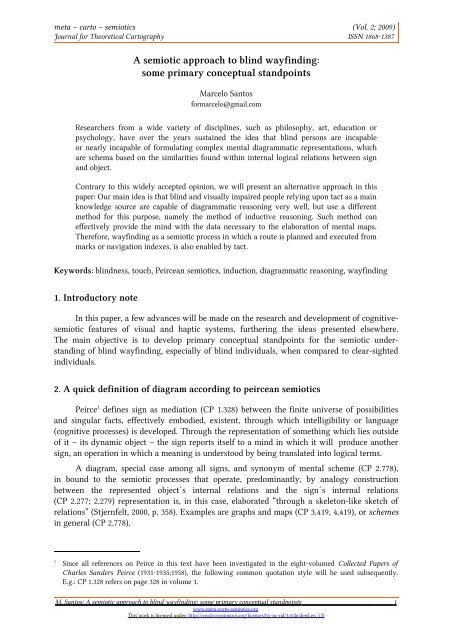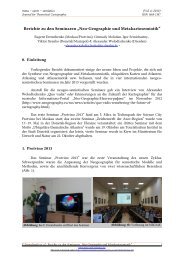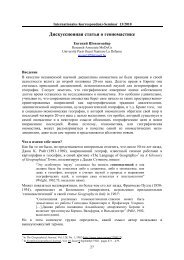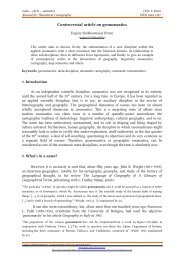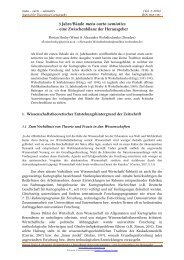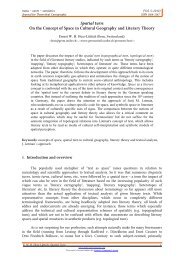A semiotic approach to blind wayfinding - Meta-Carto-Semiotics
A semiotic approach to blind wayfinding - Meta-Carto-Semiotics
A semiotic approach to blind wayfinding - Meta-Carto-Semiotics
Create successful ePaper yourself
Turn your PDF publications into a flip-book with our unique Google optimized e-Paper software.
meta – car<strong>to</strong> – <strong>semiotic</strong>s (Vol. 2; 2009)<br />
Journal for Theoretical Car<strong>to</strong>graphy ISSN 1868-1387<br />
A <strong>semiotic</strong> <strong>approach</strong> <strong>to</strong> <strong>blind</strong> <strong>wayfinding</strong>:<br />
some primary conceptual standpoints<br />
Marcelo San<strong>to</strong>s<br />
formarcelo@gmail.com<br />
Researchers from a wide variety of disciplines, such as philosophy, art, education or<br />
psychology, have over the years sustained the idea that <strong>blind</strong> persons are incapable<br />
or nearly incapable of formulating complex mental diagrammatic representations, which<br />
are schema based on the similarities found within internal logical relations between sign<br />
and object.<br />
Contrary <strong>to</strong> this widely accepted opinion, we will present an alternative <strong>approach</strong> in this<br />
paper: Our main idea is that <strong>blind</strong> and visually impaired people relying upon tact as a main<br />
knowledge source are capable of diagrammatic reasoning very well, but use a different<br />
method for this purpose, namely the method of inductive reasoning. Such method can<br />
effectively provide the mind with the data necessary <strong>to</strong> the elaboration of mental maps.<br />
Therefore, <strong>wayfinding</strong> as a <strong>semiotic</strong> process in which a route is planned and executed from<br />
marks or navigation indexes, is also enabled by tact.<br />
Keywords: <strong>blind</strong>ness, <strong>to</strong>uch, Peircean <strong>semiotic</strong>s, induction, diagrammatic reasoning, <strong>wayfinding</strong><br />
1. Introduc<strong>to</strong>ry note<br />
In this paper, a few advances will be made on the research and development of cognitive<strong>semiotic</strong><br />
features of visual and haptic systems, furthering the ideas presented elsewhere.<br />
The main objective is <strong>to</strong> develop primary conceptual standpoints for the <strong>semiotic</strong> understanding<br />
of <strong>blind</strong> <strong>wayfinding</strong>, especially of <strong>blind</strong> individuals, when compared <strong>to</strong> clear-sighted<br />
individuals.<br />
2. A quick definition of diagram according <strong>to</strong> peircean <strong>semiotic</strong>s<br />
Peirce 1 defines sign as mediation (CP 1.328) between the finite universe of possibilities<br />
and singular facts, effectively embodied, existent, through which intelligibility or language<br />
(cognitive processes) is developed. Through the representation of something which lies outside<br />
of it – its dynamic object – the sign reports itself <strong>to</strong> a mind in which it will produce another<br />
sign, an operation in which a meaning is unders<strong>to</strong>od by being translated in<strong>to</strong> logical terms.<br />
A diagram, special case among all signs, and synonym of mental scheme (CP 2.778),<br />
in bound <strong>to</strong> the <strong>semiotic</strong> processes that operate, predominantly, by analogy construction<br />
between the represented object´s internal relations and the sign´s internal relations<br />
(CP 2.277; 2.279) representation is, in this case, elaborated “through a skele<strong>to</strong>n-like sketch of<br />
relations” (Stjernfelt, 2000, p. 358). Examples are graphs and maps (CP 3.419, 4.419), or schemes<br />
in general (CP 2.778).<br />
1 Since all references on Peirce in this text have been investigated in the eight-volumed Collected Papers of<br />
Charles Sanders Peirce (1931-1935;1958), the following common quotation style will be used subsequently.<br />
E.g.: CP 1.328 refers on page 328 in volume 1.<br />
M. San<strong>to</strong>s:<br />
A <strong>semiotic</strong> <strong>approach</strong> <strong>to</strong> <strong>blind</strong> <strong>wayfinding</strong>: some primary conceptual standpoints<br />
www.meta-car<strong>to</strong>-<strong>semiotic</strong>s.org<br />
This work is licensed under: http://creativecommons.org/licenses/by-nc-nd/3.0/de/deed.en_US<br />
1
meta – car<strong>to</strong> – <strong>semiotic</strong>s (Vol. 2; 2009)<br />
Journal for Theoretical Car<strong>to</strong>graphy ISSN 1868-1387<br />
3. Diagram perception as a predominantly inductive process in <strong>blind</strong> persons<br />
Many authors suggest that the perception of objects or groups of objects that are bigger<br />
than the person’s hand is either impossible or extremely difficult for the <strong>blind</strong> (Duarte, 2004;<br />
Dunlea, 1989; Sacks, 1995). Touch could only access that, which belongs <strong>to</strong> the universe of<br />
proximity (Plaza, 1987), leaving outside all that is located away from the body and can not be<br />
embraced or acknowledged by the body at once. According <strong>to</strong> Katz (1989), those who are <strong>blind</strong><br />
are unable <strong>to</strong> build complex representations, and furthermore, in regards <strong>to</strong> the predominantly<br />
diagrammatic thought, are unable <strong>to</strong> comprehend the spatial configuration of a series of objects<br />
or of the many rooms within a house, for example.<br />
The mental schemes of a <strong>blind</strong> person would be, therefore, less complex than those of a<br />
clear sighted person. Perfect vision includes the elaboration of maps, graphs and other kinds of<br />
signs that translate a visual perception that encompasses both near and distal objects. The eyes<br />
are capable of perceiving a myriad of inputs through colors, shapes, curves, textures, etc – the<br />
many qualities which present themselves instantaneously and effortlessly (Dondis, 1997) <strong>to</strong> the<br />
visual system and, therefore, <strong>to</strong> the mind. Our understanding goes against the statement that<br />
<strong>blind</strong> persons are incapable of elaborating complex diagrammatic cognitive processes, even for<br />
big objects or groups of objects. Kennedy (1993, 1997, 2003, 2008) states that many of the spatial<br />
properties of surfaces are equally accessible <strong>to</strong> vision and tact, because a hand can perceive<br />
edges and borders that the eye can see. Therefore, we believe that those who are not capable of<br />
seeing use a logic that is predominantly distinct from that used by clear-sighted individuals in<br />
the acknowledgment of objects or groups of objects: successive temporal experimentation<br />
(Gibson apud Kennedy, 1993, p. 4), that is: the inductive investigation method.<br />
As we have suggested in previous works (San<strong>to</strong>s, 2009a, 2009b), we believe that visual<br />
perceptive processes are, <strong>semiotic</strong>ally, supported by deductive reasoning (CP 7.203): images that<br />
are captured by the eyes are soon converted in<strong>to</strong> explanations for the objects perceived, with<br />
an interpretation rule guiding <strong>to</strong>wards the interpretative result beforehand – general brings<br />
about particular. Tact, on its turn, brings about a predominantly inductive way (CP 7.206) of<br />
knowledge: through sequential experimentation, over time, the haptic system obtains<br />
fragmented data, that little by little can be unified and decoded by an interpretative rule –<br />
particular brings about general. While a computer is, for example, seen close <strong>to</strong> its entirety and<br />
almost immediately unders<strong>to</strong>od by a rule of interpretation, its examination by tact demands a<br />
series of experimentations, which are done over time: screen, keyboard, mouse, etc, all need <strong>to</strong><br />
be explored separately in order <strong>to</strong> be unified at a single subsequent moment and framed under<br />
the interpretative rule “computer”.<br />
“These would be tendencies of the visual and haptic systems, not meaning, evidently, that they can not shift<br />
positions – tact operating deductively and vision inductively – or even being a source of abduction, an<br />
“explana<strong>to</strong>ry hypothesis” (CP 5.171), which is, “after all, nothing but guessing” (CP 7.219). One must only think of<br />
a puzzle. Visual and inductively, pieces are grouped almost without any order, through a succession of<br />
experimentations, until, finally, they are comprehended as constituents of a predetermined representation: “the<br />
figure is a table”. On yet another meaning, an experiment under<strong>to</strong>ok by Klatzky, Lederman and Metzger<br />
(1985) revealed hat adults were capable of choosing from over 100 objects of common use by <strong>to</strong>uch only, with a<br />
very little margin of error, in less than two seconds – here, predominantly and in the haptic system, deductive<br />
reasoning has taken place. In regards <strong>to</strong> abduction, at any moment and any place, someone can see or <strong>to</strong>uch / be<br />
seen by something that presents itself as a discovery, a new color or material for example, a process in which one<br />
might find subsidies for reformulating theories of phenomenological interpretation which will become – deductive<br />
– rules afterwards, which will need <strong>to</strong> be validated by inductive testing.” (San<strong>to</strong>s, 2009a).<br />
M. San<strong>to</strong>s:<br />
A <strong>semiotic</strong> <strong>approach</strong> <strong>to</strong> <strong>blind</strong> <strong>wayfinding</strong>: some primary conceptual standpoints<br />
www.meta-car<strong>to</strong>-<strong>semiotic</strong>s.org<br />
This work is licensed under: http://creativecommons.org/licenses/by-nc-nd/3.0/de/deed.en_US<br />
2
meta – car<strong>to</strong> – <strong>semiotic</strong>s (Vol. 2; 2009)<br />
Journal for Theoretical Car<strong>to</strong>graphy ISSN 1868-1387<br />
This logical division proposed between vision – deduction – and tact – induction –<br />
works, we believe, for all kinds of signs, including diagrams. Let us take as an example the<br />
elaboration of the mental map of a living room by a <strong>blind</strong> person and clear-sighted person.<br />
While the visual system is capable of capturing furniture and object disposition, quickly<br />
allowing for the construction of a diagram of the room, tact will need <strong>to</strong> investigate local<br />
elements separately, gathering elements that will only be unified a posteriori in<strong>to</strong> a single<br />
scheme allowing for deliberate walking.<br />
In this manner, both tact (inductively) and vision (deductively) can conduce <strong>blind</strong> and<br />
clear sighted persons <strong>to</strong> similar interpretations, even for diagrams that allow the elaboration of<br />
complex schemes, such as, for example, a common or similar mental map of the spatial<br />
distribution of a particular place, coming from the data of visual and haptic systems.<br />
4. Blind <strong>wayfinding</strong>: navigating without seeing<br />
Nöth (1998, p. 130) states that “maps are mostly indexical signs”, representations that do<br />
not operate by similarity with the object which is being represented, but that are directly<br />
affected by such object, with which they begin <strong>to</strong> share certain qualities. They point <strong>to</strong>wards<br />
“something that exists ‘here and now’ ” (Walter-Bense, 2000, p. 16), because they involve a<br />
reaction, produced by the sign´s contact with its dynamic object. That is why “its characteristic<br />
function is <strong>to</strong> bring the interpreter´s attention <strong>to</strong> the object, exerting on the recep<strong>to</strong>r a<br />
compulsive influence” when directing a regard “<strong>to</strong> turn <strong>to</strong>wards the object, compelling the<br />
interpreter <strong>to</strong>wards an experience”, since “the index is forcibly introduced upon the mind”<br />
(Peirce apud Santaella, 2004, p. 123).<br />
Such indexical power of “pointing <strong>to</strong>wards” is, precisely, the way of car<strong>to</strong>graphical signs<br />
that are, by their very constitution, indexically affected by the space – dynamic object – which<br />
they represent, for a map must obey determined laws of spatial projection in order <strong>to</strong> function<br />
appropriately (Nöth, 1998).<br />
According <strong>to</strong> the idea that tact and vision follow distinct kinds of logic, visual and<br />
tactile car<strong>to</strong>graphy indexes should be different not only in regards <strong>to</strong> the presence of specific<br />
visual and tactile qualities, but especially in regards <strong>to</strong> the quantity of signs used <strong>to</strong> build<br />
a map.<br />
Every sign that is predominantly indexical is under the dominance of induction, but<br />
visual and tactile indexes, despite fulfilling the same function – pointing <strong>to</strong>wards a direction –<br />
require distinct <strong>semiotic</strong> strategies for diagrammatic construction: for a clear sighted person,<br />
one should indicate a route “less inductively” than for a <strong>blind</strong> person. Representing a<br />
pathway with many indexes for the clear-sighted does not mean the impossibility of<br />
knowledge about such pathway; however when it comes <strong>to</strong> the <strong>blind</strong>, building a car<strong>to</strong>graphy<br />
with the same amount of indexes used in a visual map could make <strong>blind</strong> <strong>wayfinding</strong><br />
impossible.<br />
M. San<strong>to</strong>s:<br />
A <strong>semiotic</strong> <strong>approach</strong> <strong>to</strong> <strong>blind</strong> <strong>wayfinding</strong>: some primary conceptual standpoints<br />
www.meta-car<strong>to</strong>-<strong>semiotic</strong>s.org<br />
This work is licensed under: http://creativecommons.org/licenses/by-nc-nd/3.0/de/deed.en_US<br />
3
meta – car<strong>to</strong> – <strong>semiotic</strong>s (Vol. 2; 2009)<br />
Journal for Theoretical Car<strong>to</strong>graphy ISSN 1868-1387<br />
Locomotion for a <strong>blind</strong> person entails a series of specific conditions, different from those<br />
of a clear-sighted person. According <strong>to</strong> Harper (1998, p. 15):<br />
1. Visually impaired people have preview trouble of coming objects or obstacles 2 and<br />
therefore the use of some type of preview device is important;<br />
2. consequently the stride length and therefore walking speed of a visually impaired<br />
person is less than that of a sighted person, as is the continuity of progress;<br />
3. travel for visually impaired people can be taxing and experiments often show a rise<br />
in heart rate with any travel task (although this is less for a familiar route);<br />
4. this may also explain why visually impaired people orient themselves <strong>to</strong> a waypoint<br />
about every 40 metres as opposed <strong>to</strong> 100 metres for sighted people.<br />
Such conditions do confirm our thesis that states that the haptic system – the union of<br />
the cutaneous system and deeper regions of the body [kinesthetic system of joints, tendons and<br />
muscles], plus mobility (Kennedy, 1993, pp. 11-12; 15) – operates inductively: <strong>blind</strong> persons<br />
follow a series of experiments, little by little when compared <strong>to</strong> clear sighted persons, and over<br />
time will ascertain that a specific route is being followed. We must also stress that <strong>blind</strong><br />
persons<br />
“... also use more temporal and egocentric terminology and less spatial and environmental terminology in defining<br />
points and make explicit statements on distance more often. Body rotation is also used <strong>to</strong> describe parts of a<br />
journey and route descriptions are more complex when given by a <strong>blind</strong> person. The route is broken in<strong>to</strong> a greater<br />
and more complex number of stages than when sighted people describe it, confirming the importance of a large<br />
number of fixed points [indexical signs] <strong>to</strong> a visually impaired traveler. Obstacle information is also more specific<br />
and present in greater detail when a route is described by a visually impaired person (Harper, 1998: p. 16).”<br />
That is why tactile maps produced for <strong>blind</strong> persons must entail a greater quantity of<br />
indexes – higher levels of induction – than those developed for clear sighted persons, in order<br />
<strong>to</strong> enable <strong>wayfinding</strong>, “the process of determining and following a path or route between a<br />
origin and a destination” (Golledge, 1999, p. 6)), and navigation, defined as “updating one’s<br />
position and orientation during travel with respect <strong>to</strong> the intended route or desired destination<br />
and, in the event of becoming lost, reorienting and reestablishing travel <strong>to</strong>ward the<br />
destination” (Loomis et al., 1998, p. 193).<br />
Considering this fact is fundamental, assuming that maps, be they mental or material, are<br />
the initial <strong>to</strong>ol for planning a route, and can, therefore, help minimize “limitation in orientation<br />
and mobility (…) considered the most serious effect of <strong>blind</strong>ness upon the individual” (Welser<br />
apud Felippe & Felippe, 1997: p. 107). Usually <strong>blind</strong> children are late in their spatial and<br />
movement development when compared <strong>to</strong> clear sighted children (Amiralian, 1997, p. 61;<br />
Bruno, 1993, p. 19; Felippe & Felippe, 1997; Heimers, 1970, p. 13). In fact,<br />
“ ... lots of <strong>blind</strong> children are capable of walking, but do not walk for fear and insecurity of moving without being<br />
able <strong>to</strong> get orientation and control from the environment, so they will usually walk after a year and a half or<br />
more. They need someone <strong>to</strong> walk them, <strong>to</strong> give them a sense of security through physical <strong>to</strong>uch and who will<br />
anticipate patterns using sound so they can pursue mo<strong>to</strong>r organization and achieve mo<strong>to</strong>r walking patterns by the<br />
experience with another.” (Bruno, 1993, p. 19)<br />
2 In the original, Harper (1998, p. 15) states that “visually impaired people have no preview of coming objects or<br />
obstacles”. We disagree with this assumption, considering that <strong>to</strong>uch works on the perception of nearby and<br />
distal objects, albeit with some limitations for the latter when compared <strong>to</strong> vision. As demonstrated by<br />
Kennedy (1993: p. 14), “just as we can see through a transparent surface-looking (…) we can feel through a<br />
nearby surface <strong>to</strong> detect a more distant object” (ibid.: 12). It is the case, for example, of the “pressures generated<br />
by the wind of passage of a [distal] train” (ibid.).<br />
M. San<strong>to</strong>s:<br />
A <strong>semiotic</strong> <strong>approach</strong> <strong>to</strong> <strong>blind</strong> <strong>wayfinding</strong>: some primary conceptual standpoints<br />
www.meta-car<strong>to</strong>-<strong>semiotic</strong>s.org<br />
This work is licensed under: http://creativecommons.org/licenses/by-nc-nd/3.0/de/deed.en_US<br />
4
meta – car<strong>to</strong> – <strong>semiotic</strong>s (Vol. 2; 2009)<br />
Journal for Theoretical Car<strong>to</strong>graphy ISSN 1868-1387<br />
Furthermore, what a <strong>blind</strong> child or even a <strong>blind</strong> adult needs is <strong>to</strong> be embraced by the<br />
environment, <strong>to</strong> find positive cognitive conditions that are conducive <strong>to</strong> their mobility, such as<br />
the conditions offered <strong>to</strong> other individuals: “If directional cues are available for guidance<br />
during <strong>blind</strong> travel, a <strong>blind</strong> individual may be able <strong>to</strong> continuously adjust the traveling path<br />
until reaching the final destination with minimal worry of getting lost” (Tang & Beebe, 2006,<br />
p. 116). Among these direction cues, we believe that indexes prone <strong>to</strong> inductive cognition<br />
should be contemplated through a tactile logic of spatial investigation, so that the following of<br />
a desired route by <strong>blind</strong> persons is ensured.<br />
5. Indexes for <strong>blind</strong> <strong>wayfinding</strong><br />
Harper (1998, p. 21) proposes five kinds of indexes for <strong>wayfinding</strong>:<br />
1. Route planning: Plan a journey, and decide on a route before hand, based on maps<br />
and/or previous knowledge [mental maps] of the route or journey;<br />
2. Obstacle detection and avoidance: While traveling, constantly detect and avoid any<br />
obstacles, either stationary (lampposts, walls, etc.) or moving (people, cars, etc.);<br />
3. Orientation and waypoints: The journey will be sectioned in<strong>to</strong> waypoints/wayedges.<br />
These allow some means of orientation, and travelers naturally divide a journey in<strong>to</strong><br />
Sections with a waypoint as the start and finish (road junctions, landmarks, etc);<br />
4. Information points: Information points are points along a journey where information<br />
about the journey is available (timetables, next bus information, etc);<br />
5. In-route guidance: In-route guidance is sometimes performed. This may be by asking<br />
for directions or by carrying a map.<br />
We can see, therefore, that a route is constituted by its car<strong>to</strong>graphy and latter navigation<br />
moni<strong>to</strong>ring of different stages of the journey. The objective is <strong>to</strong> ensure that the indexes<br />
defined by the map in order <strong>to</strong> ascertain the following of a route will be, afterwards,<br />
diagrammatically found at the “real world”, establishing a parallel between sign and object that<br />
allows for deliberate locomotion.<br />
Three types of fixed indexical signs would be necessary for the proper enacting<br />
of <strong>wayfinding</strong>: waypoints, orientation points and information points. According <strong>to</strong><br />
Harper (1998, p. 19), these:<br />
“... are all intended <strong>to</strong> represent some form of information giving object. A waypoint for instance may be just an<br />
arbitrary (implicit) point (say, where two roads/tracks meet) or it may be a specific (explicit) point intended <strong>to</strong> be a<br />
waypoint (a beeping sound marker, say). It is however intended that the information point will represent some<br />
form of device that gives complex information (for example a timetable, or street map ‘information point’).”<br />
Another kind of fundamental fixed index is called way-edge. As previously mentioned,<br />
tact is as capable as vision <strong>to</strong> detect spatial frontiers which differentiate objects and sets of<br />
objects from one another. Therefore, a way-edge is an important resource for the <strong>blind</strong>, who<br />
“... may also use a continuous or largescale object as a kind of waypoint. This could be called a ‘way-edge’, as it is<br />
possible that this object is followed until it ends or some other fac<strong>to</strong>r or object is met. For instance, an individual<br />
may walk along the edge of a wall using the entire structure as a reference point <strong>to</strong> where they are (a sequence of<br />
closely spaced waypoints if you will) (Harper, 1998, pp. 19-20).”<br />
M. San<strong>to</strong>s:<br />
A <strong>semiotic</strong> <strong>approach</strong> <strong>to</strong> <strong>blind</strong> <strong>wayfinding</strong>: some primary conceptual standpoints<br />
www.meta-car<strong>to</strong>-<strong>semiotic</strong>s.org<br />
This work is licensed under: http://creativecommons.org/licenses/by-nc-nd/3.0/de/deed.en_US<br />
5
meta – car<strong>to</strong> – <strong>semiotic</strong>s (Vol. 2; 2009)<br />
Journal for Theoretical Car<strong>to</strong>graphy ISSN 1868-1387<br />
The problem is that, on our daily lives, waypoints, orientation points, information points<br />
and way-edges are, more often than not, signs which are built <strong>to</strong> be read by vision only, and<br />
not through hearing or tact, given that “<strong>to</strong>uch has become not only restricted in its<br />
communicative potential but also repressed by the norms of societies” (Nöth, 1998, p. 407),<br />
what makes <strong>blind</strong> orientation particularly difficult.<br />
At this point we must say that – although tact is the sense that, besides vision, enables<br />
spatial recognition, and object recognition – hearing has also proven <strong>to</strong> serve as an efficient aid<br />
<strong>to</strong> <strong>blind</strong> spatial navigation (Bennett, 2002; Holland et al., 2002). This happens because sound<br />
can function inductively as a non-visual car<strong>to</strong>graphical index, according <strong>to</strong> a tactile logic of<br />
acknowledgment – experience/action-reaction – , when indicating previously established<br />
points in a map, activating waypoints, orientation points, information points and even wayedges.<br />
3 Moreover, hearing signs might be used as information points in case someone gets lost.<br />
One must bear in mind, however, that <strong>blind</strong> <strong>wayfinding</strong> might happen without hearing, but<br />
not without tact.<br />
Regarding available <strong>to</strong>ols for <strong>wayfinding</strong>, there is a need for the development of gadgets<br />
that, in addition <strong>to</strong> representing in space points that are given by a map, do also represent the<br />
occurrence of unforeseen obstacles, be they fixed or mobile. Among the common aids given <strong>to</strong><br />
the <strong>blind</strong>, Almeida (2008, pp. 112-113) highlights the following:<br />
1. Sticks: work as extensions of tact (Gibson, 1966, p. 100), perceiving vibrations from<br />
surfaces;<br />
2. Sighted guide: clear sighted person who informs the <strong>blind</strong> about space, also guiding<br />
him/her;<br />
3. Dog: trained dog. Stimulates speed, independence and provides company;<br />
4. Technology: a variety of local and global positioning systems (e.g., GPS, LORAN,<br />
VOR-DME) in which the naviga<strong>to</strong>r determines current position using signals from<br />
transmitters at known locations (Loomis et al., 1998, pp. 194-195), informing about<br />
routes, obstacles and other data relevant for mobility.<br />
All of these are <strong>semiotic</strong> mechanisms encompassed by cognitive processes which are<br />
predominantly inductive, through the creation of possible sequential access <strong>to</strong> a large amount<br />
of indexes. Even a clear sighted guide must be an inter<strong>semiotic</strong> transla<strong>to</strong>r of deductive visual<br />
knowledge in<strong>to</strong> inductive verbal knowledge when describing a place for the <strong>blind</strong>; otherwise<br />
he or she will not accomplish their task.<br />
6. Summary and future work<br />
Sight impaired and <strong>blind</strong> persons are, via induction, capable of <strong>wayfinding</strong> and<br />
navigation over predetermined routes defined by car<strong>to</strong>graphy, either through mental or<br />
material maps. In order <strong>to</strong> achieve this, signs must be available <strong>to</strong> the traveler that can be read<br />
according <strong>to</strong> his/her own cognitive necessities and abilities, somehow distinct – and by no<br />
means inferior – from those of clear-sighted individuals. By adopting a predominantly<br />
indexical/inductive logic, a same diagram might be easily perceived and executed by someone<br />
who is visually impaired, as long as a greater amount of indexes is offered.<br />
3 Wayedge: the continuing and/or interruption of a given sound while a frontier is followed.<br />
M. San<strong>to</strong>s:<br />
A <strong>semiotic</strong> <strong>approach</strong> <strong>to</strong> <strong>blind</strong> <strong>wayfinding</strong>: some primary conceptual standpoints<br />
www.meta-car<strong>to</strong>-<strong>semiotic</strong>s.org<br />
This work is licensed under: http://creativecommons.org/licenses/by-nc-nd/3.0/de/deed.en_US<br />
6
meta – car<strong>to</strong> – <strong>semiotic</strong>s (Vol. 2; 2009)<br />
Journal for Theoretical Car<strong>to</strong>graphy ISSN 1868-1387<br />
We must also emphasize that the indexes used by clear-sighted persons in navigation<br />
also follow an inductive knowledge process, since they operate according <strong>to</strong> visual experiences.<br />
In fact, what we are suggesting is that when tact is the main source of knowledge, the amount<br />
of indexes must be greater than the amount required by vision, which is prone <strong>to</strong> deduction.<br />
In future works, we intend <strong>to</strong> address two main questions: 1) How does hearing, by<br />
appropriation of inductive tactile logic, help on <strong>blind</strong> <strong>wayfinding</strong> through technologies that use<br />
sound as a primary language? What kinds of data are better transmitted via sound or tact, even<br />
when both follow the same tactile inductive logic of recognition/spatial localization? 2) Deepen<br />
research about tactile technologies for <strong>blind</strong> <strong>wayfinding</strong>, from wooden canes <strong>to</strong> laser and <strong>to</strong> the<br />
oral tactile interface for <strong>blind</strong> navigation, designed by Tang & Beebe (2006).<br />
7. Acknowledgments<br />
I shall thank Professor Winfried Nöth for providing some of the texts used in this<br />
research and the Foundation for Research Support of São Paulo (FAPESP), for funding.<br />
Moreover, I would like <strong>to</strong> thank the edi<strong>to</strong>rs of meta-car<strong>to</strong>-<strong>semiotic</strong>s for their fruitful comments<br />
given during the review process, which helped <strong>to</strong> make some points clearer and more explicit.<br />
8. Author information<br />
Currently, doc<strong>to</strong>ral student in Communication and <strong>Semiotics</strong> at Pontifícia Universidade<br />
Católica de São Paulo, PUC/SP, BRAZIL, advised by Prof. Lucia Santaella and financed by<br />
FAPESP. Main interests: Peircean <strong>semiotic</strong>s; <strong>blind</strong> communication process; pic<strong>to</strong>rial language;<br />
interfaces between <strong>semiotic</strong>s and psychoanalysis; applied <strong>semiotic</strong>s; systems theory.<br />
9. References<br />
Almeida, M. D. F. (2008). Auxílios à navegação de pedestres cegos através de mapa tátil. Programa de<br />
Pós-graduação em Design Gráfico da UFPE: Dissertação de Mestrado.<br />
Amiralian, M. L. T. M. (1997). Compreendendo o cego: uma visão psicanalítica da cegueira por meio de<br />
Desenhos-Estórias. São Paulo: Casa do Psicólogo.<br />
Bennett, D. (2002). Effects of Navigation and Position on Task When Presenting Diagrams <strong>to</strong> Blind<br />
People Using Sound. In M. Hegarty, B. Meyer, & N. Hari Narayanan (eds.), Diagrams 2002, LNAI<br />
2317 (pp. 161-175).<br />
Bruno, M. M. G. (1993). O desenvolvimen<strong>to</strong> integral do portador de deficiência visual: da intervenção<br />
precoce à integração escolar. São Paulo: Newswork.<br />
Dondis, D. (1997). Sintaxe da Linguagem visual. São Paulo: Martins Fontes.<br />
Duarte, M. L. B. (2004). Imagens mentais e esquemas gráficos: ensinando desenho a uma criança cega.<br />
In M. B. Medeiros (ed.), Arte em pesquisa: Ensino e aprendizagem da arte e linguagens visuais<br />
(Vol. 2, pp. 134-140). Brasília: Universidade de Brasília.<br />
Dunlea, A. (1989). Vision and the emergence of meaning. Cambridge: Cambridge University Press.<br />
Felippe, J. Á., & Felippe, V. L. (1997). Orientação e mobilidade. In M. M. G. Bruno (ed.), Deficiência<br />
visual: reflexão sobre a prática pedagógica. São Paulo: Laramara.<br />
Gibson, J. J. (1966). The senses considered as perceptual systems. Bos<strong>to</strong>n: Mifflin.<br />
Golledge, R. (1999). Human Wayfinding and Cognitive Maps. In R. Golledge (ed.), Wayfinding<br />
behavior: cognitive mapping and other spatial processes (pp. 5-45). Baltimore: The John Hopkins<br />
University Press.<br />
M. San<strong>to</strong>s:<br />
A <strong>semiotic</strong> <strong>approach</strong> <strong>to</strong> <strong>blind</strong> <strong>wayfinding</strong>: some primary conceptual standpoints<br />
www.meta-car<strong>to</strong>-<strong>semiotic</strong>s.org<br />
This work is licensed under: http://creativecommons.org/licenses/by-nc-nd/3.0/de/deed.en_US<br />
7
meta – car<strong>to</strong> – <strong>semiotic</strong>s (Vol. 2; 2009)<br />
Journal for Theoretical Car<strong>to</strong>graphy ISSN 1868-1387<br />
Harper, S. (1998). Standardising electronic travel aid interaction for visually impaired people<br />
(PhD Thesis). Manchester: UMIST.<br />
Heimers, W. (1970). Como devo educar meu filho cego: um guia. São Paulo: Fundação para o Livro do<br />
Cego no Brasil.<br />
Holland, S., Morse, D. R., & Gedenryd, H. (2002). AudioGPS: Spatial Audio Navigation with a Minimal<br />
Attention Interface. Personal and Ubiqui<strong>to</strong>us Computing, 6(4), 253-259.<br />
Katz, D. (1989). The world of <strong>to</strong>uch Hillsdale, New Jersey: Lawrence Erlbaum Associates Inc.<br />
Kennedy, J. (1993). Drawing and the <strong>blind</strong>. New Haven: Yale University Press.<br />
Kennedy, J. (1997). How the <strong>blind</strong> draw. Scientific American, Special Edition, 76-81.<br />
Kennedy, J. (2003). Drawings from Gaia, a <strong>blind</strong> girl Perception, 31(5), 1013-1026.<br />
Kennedy, J. (2008). <strong>Meta</strong>phoric drawings devised by an early-<strong>blind</strong> adult on her own initiative.<br />
Perception, 37(11), 1720-1728.<br />
Klatzky, R. L., Lederman, S. J., & Metzger, V. A. (1985). Identifying objects by <strong>to</strong>uch: an "expert system".<br />
Perception & Psychophysics, 37(4), 299-302.<br />
Loomis, J. M., Golledge, R. G., & Klatzky, R. L. (1998). Navigation System for the Blind: Audi<strong>to</strong>ry<br />
Display Modes and Guidance. Presence: Teleopera<strong>to</strong>rs & Virtual Environments, 7(2), 193-203.<br />
Nöth, W. (1998). Car<strong>to</strong>ssemiótica. In A. Oliveira & Y. Fechine (eds.), Visualidade, urbanidade,<br />
intertextualidade. São Paulo: Hacker Edi<strong>to</strong>res.<br />
Peirce, C. S. (1931). Collected Papers of Charles Sanders Peirce. (C. Hartshorne & P. Weiss, eds.).<br />
Cambridge: Harvard University Press.<br />
Peirce, C. S. (1958). Collected Papers of Charles Sanders Peirce. (A. W. Burks, ed.). Cambridge: Harvard<br />
University Press.<br />
Plaza, J. (1987). Tradução intersemiótica. São Paulo: Perspectiva.<br />
Sacks, O. (1995). Um antropólogo em marte. São Paulo: Companhia das Letras.<br />
Santaella, L. (2004). A teoria geral dos signos: como as linguagens significam as coisas. São Paulo:<br />
Pioneira Thomson Learning.<br />
San<strong>to</strong>s, M. (2009a). Ta<strong>to</strong> e Visão: Diferenças e Interconexões Cognitivas. In Proceedings: 12 Jornada de<br />
Estudos Peirceanos. São Paulo.<br />
San<strong>to</strong>s, M. (2009b). Touch and Vision: Interconnections for Diagrammatical Reasoning. In Culture of<br />
Communication, Communication of Culture. Paper presented at the X World Congress of <strong>Semiotics</strong>:<br />
University of Coruña & International Association for Semiotic Studies.<br />
Stjernfelt, F. (2000). Diagrams as centerpiece of a peircean epistemology. Transactions of the Charles S.<br />
Peirce Society, 36(3), 357-385.<br />
Tang, H., & Beebe, D. J. (2006). An oral tactile interface for <strong>blind</strong> navigation. IEEE Transactions On<br />
Neural Systems And Rehabilitation Engineering, 14(1), 116-123.<br />
Walter-Bense, E. (2000). A teoria geral dos signos: introdução aos fundamen<strong>to</strong>s da semiótica. São Paulo:<br />
Perspectiva.<br />
M. San<strong>to</strong>s:<br />
A <strong>semiotic</strong> <strong>approach</strong> <strong>to</strong> <strong>blind</strong> <strong>wayfinding</strong>: some primary conceptual standpoints<br />
www.meta-car<strong>to</strong>-<strong>semiotic</strong>s.org<br />
This work is licensed under: http://creativecommons.org/licenses/by-nc-nd/3.0/de/deed.en_US<br />
8


